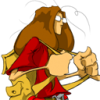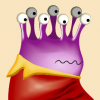🎉 Celebrating 25 Years of GameDev.net! 🎉
Not many can claim 25 years on the Internet! Join us in celebrating this milestone. Learn more about our history, and thank you for being a part of our community!
[color=rgb(51,51,51)][font=Georgia]I'm working on a puzzle game for iPads that takes the mechanics of a somewhat obscure game from the 1990s(*) and puts them on a double logarithmic spiral.[/font][/color]
The final app will be styled similar to one of M. C. Escher's tessellations of the plane with the tessellation changing at level breaks. I don't have a name yet...[/font][/color]
ift turns out to be too immature in which case I'll use C++ and Cocos2d-x again.[/font][/color]
I'm working on a puzzle game for iPads that takes the mechanics of a somewhat obscure game from the 1990s(*) and puts them on a double logarithmic spiral.[/font][/color]
The final app will be styled similar to one of M. C. Escher's tessellations of the plane with the tessellation changing at level breaks. I don't have a name yet...[/font][/color]
ift turns out to be too immature in which case I'll use C++ and Cocos2d-x again.[/font][/color]
Previous Entry
Discretely Distributed Random Numbers in C#
Comments

October 18, 2014 07:54 AM

I'm going to write a journal entry about the mathematics involved in using a spiral game grid like that. Not that it would come up a lot, but it is kind of interesting.
Basically for the animation you are talking about: each cell knows its scale, translation from the center, and rotation about the center. To draw a cell you perform affine transformation on a " base" cell. To do the animation you linear interpolate the scale, rotation, etc. between the start cell and the destination cell.
October 18, 2014 06:53 PM
Advertisement
Latest Entries
Triangle Plasma
1678 views
Triangular Life
2658 views
draak update
3218 views
Untitled Escher Game Update
3134 views
What I am working on
3065 views
Discretely Distributed Random Numbers in C#
6247 views
Cocos2d-x + Box2d Breakout Updated
2731 views
Advertisement
How the hell did you animated the squares down the spiral (the transition to the next one)??